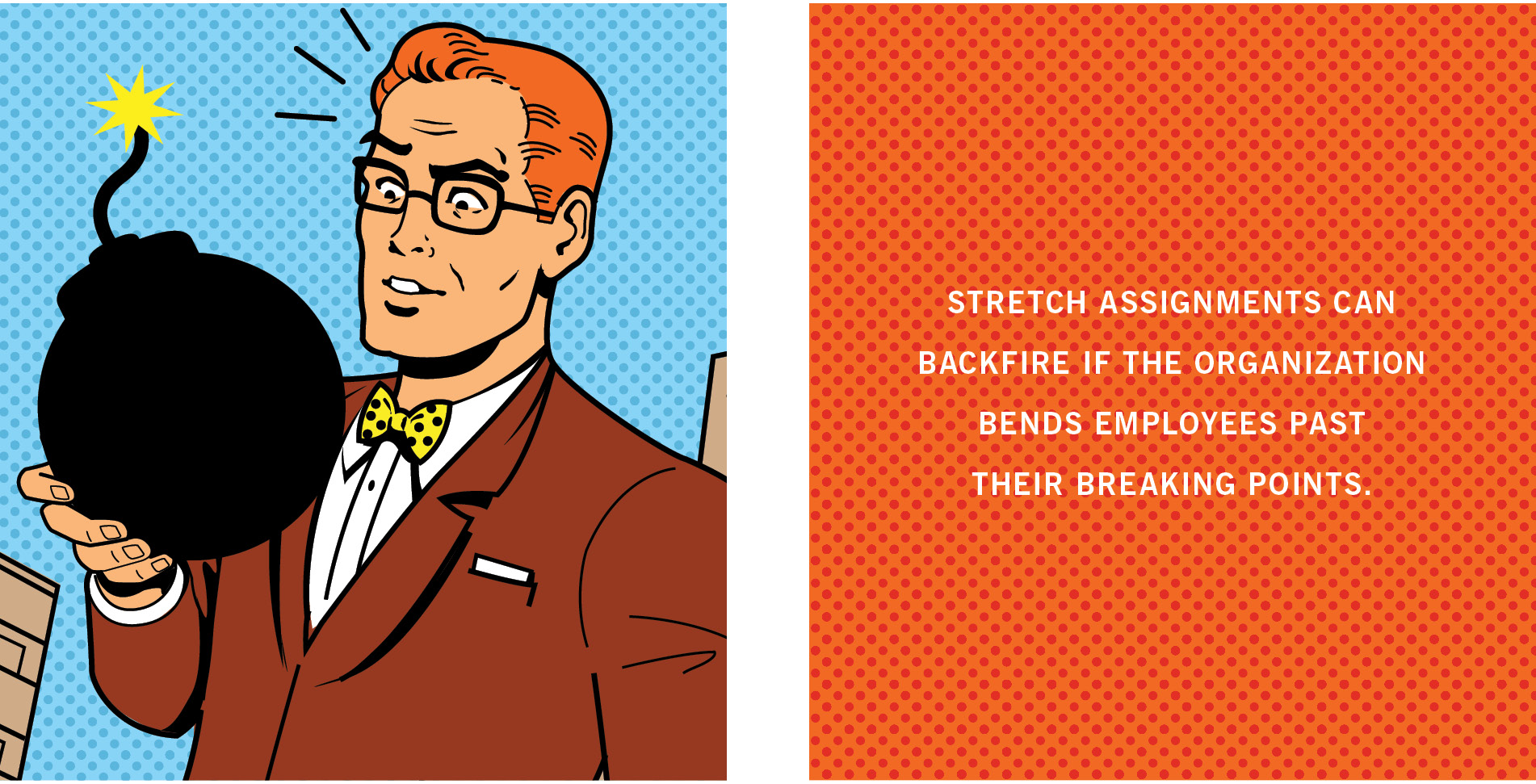Stretching can come in three forms:
-
Circumstantial.
By no choice of his or her own, someone is faced with adversity or confronted with a challenge to overcome. Batman struggled by seeing his parents murdered. That motivated him to fight evil and ultimately become a superhero.
-
Self-initiated.
Someone has the desire to do more than what is expected and takes the initiative to stretch beyond his or her limits. Unbeknownst to her Amazon Queen mother, Princess Diana competed to become the hero Wonder Woman, then saving humans on Earth.
-
Assigned.
A leader sees potential in a high-performing individual and wants to see him or her grow. Professor X recruits Scott Summers, the mutant who beams force blasts from his eyes, to be one of the leaders of the X-Men as his alter-ego of Cyclops.
Satisfaction comes from the positive outcome — that is, overcoming a struggle — that can result from one of the three stretching scenarios. So how can business leaders motivate their employees to stretch, and therefore enable growth?
Employee and Organizational Benefits
Stretch assignments are extremely effective leadership, learning, and development tools, but are often underused in the workplace. By definition, stretch assignments are those “extra” projects employees volunteer for — or are “volun-told” for — that are outside those employees’ comfort zones or beyond their immediate skill sets.
High-performing employees are the target for stretch assignments. Such assignments can solidify the leadership pipeline within an organization, and they have several other benefits, both for the employee and the organization:
For the employee, stretch assignments:
-
Boost confidence and enhance visibility.
When an employee is tapped for a stretch assignment, leadership eyes are on him or her. For employees motivated by recognition, stretch assignments are a fantastic tool.
-
Focus his or her career path.
What better way to explore other functions or departments than to take a “test drive”? Employees who try stretch assignments, new activities or roles they haven’t filled before, will learn what they like and don’t like so they can plan their next career move accordingly.
-
Teach new skills and forge new relationships.
Employees have the opportunity to learn different parts of the business and interact with leadership across the company during stretch assignments. The skills the employee learns and relationships he or she makes carry back to the day-to-day job and strengthen the employee’s network for future opportunities.
For the organization, stretch assignments:
-
Create real results.
Unlike training programs and simulated learning environments, stretch assignments focus on real work the organization must do. Stretch assignments can take the form of a task force or an individual project that is solving an actual business problem.
-
Lower costs.
Stretch assignments using high-potential employees typically don’t cost the organization any additional money or investment. The employee is on the books already.
-
Increase employee loyalty and engagement.
When employees feel they are receiving “special treatment” from leadership, they often are more engaged and willing to spend their discretionary effort on improving their organizations. The key to making stretch assignments work is capitalizing on employees’ discretionary effort, as these assignments are often in addition to day-to-day work.



Who to Stretch — and When
While stretch assignments can help employees feel appreciated and yield benefits for the organization, it is critical that leaders know how to decide who should get such assignments and when to hand them out.
A stretch assignment for one person may not look the same as a stretch assignment for another. To be effective, leaders must individualize assignments to the person, have a solid understanding of what the employee is capable of, as well as how he or she wants to develop him- or herself.
A few considerations:
-
Choose carefully who gets stretch assignments.
They should only go to high performers as a means to develop them, retain them long-term, and identify the company’s leadership pipeline.
-
Choose carefully when employees get stretch assignments.
What is their work load? Can they deprioritize competing commitments to accomplish the task set before them? Do they have issues in their personal lives that would prevent them from taking on the additional work and increased leadership visibility?
-
Choose carefully what the assignment is and its duration.
A stretch assignment can last a couple of days or a couple of months. Discussing the scope and duration of the assignment with the employee can determine if it is doable, yet still challenging. This is not an opportunity for the employee to back away from the assignment, but to diagnose his or her readiness. If stretching is possible and appropriate, the leader and employee should collaborate on the details.

The effectiveness of stretch assignments depends on the degree to which the employee struggles. These personal and professional struggles can motivate and encourage individuals, particularly those who are more competitive. Employees – and Superheroes – look forward to the sense of satisfaction achieved by overcoming a challenge.
Of course, leaders don’t want to overwhelm or overburden employees by having them face a seemingly impossible task. Again, stretch assignments, when they’re not used properly, can be risky. These risks include lower employee morale and higher attrition. In other words, stretch assignments can backfire if the organization bends employees past their breaking points.
For these reasons, it is critical for leaders to mentor and grow their people, understanding what their developmental needs are, and whether stretch assignments are a good tool.
Stretch assignments should be used as a tool to motivate, develop, and one hopes, retain high-performing employees. Remember the “Stretch Armstrong” doll? He can stretch very far, but at some point, he can and will break — POW! — if stretched beyond limits. Leaders must know their employees’ limits. Push those limits, but not too far.
Leaders who take on the responsibility, and who know when to push and pull the levers of stretch assignments properly, will create Superheroes.
